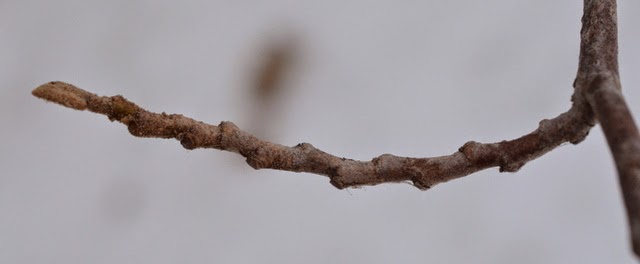.JPG)
The end of winter is rapidly approaching and before it does, I wanted to take a last minute inventory of twigs. In identifying twigs, I've found dichotomous keys to be extremely helpful, but rarely use them while out in the field. When identifying species in the woods I also typically don't use the same thinking to identify twigs that I would while using a key at home, perhaps because I'm not as skilled as a botanist and don't have the familiarity with the technical aspects of twig ID to call it up in my head. This became more obvious while out at the LaPlatte River in Shelburne.
To start, since I've got some familiarity with twig anatomy, I wanted to photograph the different anatomical parts then create my own dichotomous key to some of the most common in the area. Below are the different aspects of a twig shown on various species moving from the stem of the plant out to the tip. A twig, by the way, is technically all the current year's growth (i.e. everything produced by the tree since bud burst in the most recent spring).
.JPG) |
| Spur branch on common buckthorn (Rhamnus cathartica) |
Spur branch
Spur branches are tiny branches formed from lateral buds and can be several years old. They tend to be found on more shade tolerant species. These species don't put on a lot of growth each year and retain leaves in roughly the same position on the plant year after year (great examples can be found on yellow birch). These are not monophyletic (found on one evolutionary branch), and show up in some conifers (e.g. tamaracks) as well as broad-leafed trees.
.JPG) |
| Bud scale scar on red-osier dogwood (Cornus sericea) |
Annular scar or bud scale scar
A bud is essentially a mini branch hording tini little leaves and/or flowers flowers inside. Where the bud covering of the terminal bud falls off, it leaves a scar fully encircling the branch. This can often be discerned by finding a clear change in color from the older to the more current year. Depending on the species, this color is apparent going back four to six years.
.JPG) |
| Spongy pith of white ash (Fraxinus americana) |
Pith
Pith is parenchyma tissue. Parenchyma is basically just undifferentiated cells with thin cell walls. You find parenchyma cells in highly active growth areas (like the tips of twigs). In twigs, pith is the origination site of buds. It is typically white and spongy when young, though as it ages it will discolor and break. Depending on how it ages, pith can be solid, spongy, chambered, or hollow.
.JPG) |
| My fingerprint on whitish bloom protective covering on twigs and 2-year-old growth on boxelder (Acer negundo) |
Bark coverings
Some first year twigs are coated in hairs (pubescent), others have a white bloom to them. I still don't know what this white bloom is, but it's the same stuff found on raspberry twigs, grapes, and lots of other fruits like apricots.
.JPG) |
| Lenticels of boxelder (Acer negundo) |
Lenticels
The mouth holes of the tree that open in the cork of tree (cork is the protective outer tissue of the bark). This is where gas exchange happens on the stem of the plant (occurs on the stomata of leaves). Many species have adaptations within the bark to protect the tree from fire, predators, damage from flooding, etc. The thicker bark on these species blocks off gas exchange. Look for lenticels on younger, thinner barked parts of trees.
.JPG) |
| Lateral buds off a red maple (Acer rubrum) |
Lateral buds
Running up the branch of the tree, these are all the buds that aren't at the tip of the twig. They can be arranged alternately, opposite, sub-opposite, or whorled. Our only deciduous whorled tree here in Vermont is the catalpa (I think). The vast majority are alternate. This is largely a characteristic shared by all members of a given genus. MAD Cap Horse works as a mnemonic to remember the opposite branched trees (
Maples
Ashes
Dogwoods
Caprifoliacea - the honeysuckle, viburnum family
Horse chestnut).
.JPG) |
| Bundle scar (black) and Leaf scar (grayish) looking monkey face of a butternut (Juglans cinerea) |
Leaf scar + Bundle scar
A petiole connects the leaf to the branch. Petioles come in a wide range of shapes from the u-shape of celery stalks to the flattened wagging stems of aspen leaves. Nutrients are fed into the leaf (and siphoned back down to the roots) via vascular tissue in bundles. When the leaf falls off it exposes bundle scars - the parts where the tubes flow from the stem into the leaf - illuminating the arrangement of these bundles, which is unique to each species. Butternut scars have the appearance of a funny little monkey face.
Terminal Bud
The terminal bud is the apex of the shoot (also called an apical bud). It usually points directly out and is larger than the lateral buds. As with lateral buds, it contains miniature leafs and flowers.
Over the coming weeks I'll be drawing out a dichotomous key by drawing attention to these features and others of some of the more common wild and naturalized species found in my part of Vermont.




.JPG)
.JPG)
.JPG)
.JPG)
.JPG)
.JPG)
.JPG)
.JPG)
.JPG)
.JPG)
.JPG)
.JPG)
.JPG)
.JPG)
.JPG)
.JPG)
.JPG)
.JPG)

.JPG)

.JPG)
.JPG)
.JPG)

.JPG)
.JPG)

.JPG)




.JPG)

.JPG)
.JPG)
.JPG)
.JPG)
.JPG)
.JPG)
.JPG)
.JPG)
.JPG)
.JPG)
.JPG)
.JPG)
.JPG)
.JPG)
.JPG)
.JPG)
.JPG)